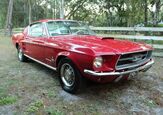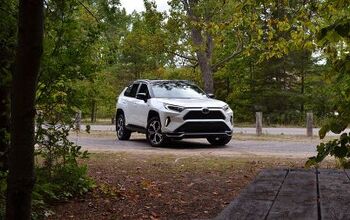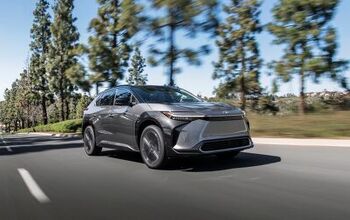2026 Toyota RAV4 First Drive Review: The Everything Burger

This is easily the most important launch of the year. Get ready to see a whole lot of the 2026 Toyota RAV4 on roads near you, the latest version of America’s—and Canada’s—favorite SUV.
Seriously, Toyota has sold over 14 million RAV4s since the model debuted 30 years ago, and currently hawks the thing in over 180 countries. For its latest edition this titan of the industry is going all-hybrid, and even includes a GR Sport model on the 324-horsepower plug-in hybrid model. The RAV4’s customer base is everyone. The billion-dollar question is whether the improvements Toyota has wrought on this family ‘ute will keep it on top, so to find out I drove it not once but twice—around Scottsdale, Arizona as well as southern Ontario, including a tour of the Woodstock plant where it’s built.
2026 Toyota RAV4 Quick Take
The 2026 Toyota RAV4 is better in nearly every way, and going all-in on hybrids is likely a long-term win. Those wishing for more rugged options will be left in the cold though—and we still need to know pricing.
What’s New for 2026:
Easily the biggest news is the move to a fully hybrid lineup. This means a front-drive hybrid joins the lineup (in America). The plug-in hybrid expands to more grades, with some even gaining access to DC fast charging. Toyota expects the PHEV to eventually account for over 20 percent of RAV4 sales, up from today’s 8 percent.
Toyota has tweaked the RAV4 lineup to set up three distinct buckets for buyers to fall into: core, sport, and outdoor. The core models are the familiar volume trims: LE, XLE, and Limited. There are three on the sport side as well: SE, XSE, and GR Sport. (You can read our separate break-out review of the GR Sport here.) Outdoor is just one trim for now in the shape of the Woodland, which gets some chunkier styling, added exterior lighting, and all-terrain rubber.
While sitting on the same essential TNGA-K platform as before, with the same measurements, the ‘26 RAV4 sees a 10-percent improvement in structural stiffness by way of more high-strength steel. Packaging tweaks have also freed up more cargo capacity for the plug-in models.
Exterior Style:
It’s been five months since we first saw the ‘26 RAV4 and its altogether blockier take on Toyota’s current “hammerhead” front-end designs. In isolation it can look a little awkward, especially with the Limited trim’s chrome highlights hidden within the cheese-grater grille. It’s just a rhinoplasty, right?
Park it next to an existing RAV4 however, and the changes become more apparent. The character lines are sharper, the angles more clearly defined. There is a complicated confluence of volumes that all meet just ahead of the rear door handles; from certain angles it gives the RAV4 a strong shoulder line, while others look like an errant shopping cart got a little too friendly. You’ll still find the two bits of black plastic on the A- and D-pillars too, a carryover styling oddity from the fifth-generation model.
The back half of the RAV4 sees more glass surface, improving visibility. Larger taillights now connect via black-out panel with a redesigned RAV4 logo tying it all together. This is the new model’s best angle in my opinion, even if the taillight shape is giving Rogue.
The Woodland goes its own way with fractionally wider arches, a bluffer front end complete with Rigid foglights, and 18-inch wheels wrapped in all-terrain rubber.
Wheels range from 17 to 20 inches, depending on trim.
2026 Toyota RAV4: All the Details
Powertrain and Fuel Economy:
The adoption of the fifth-generation Toyota hybrid system sees power up across the board. Front-drive models boast a healthy 226 horsepower, while electronic on-demand all-wheel drive is optional (and standard in Canada). This adds an additional motor acting exclusively on the rear axle, contributing up to 89 pound-feet of torque on its own and bumping combined system horsepower by 10 ponies.
Out on the road, the added oomph isn’t immediately noticeable, as the sixth-gen RAV4 has also gained around 100 pounds trim for trim. What is noticeable is the increased smoothness with which it makes its progress, both in the better blending between propulsion sources and the muffled sounds when requesting full power from the internal combustion side. The old model blared during on-ramp runs or passing bursts; the ‘26 is an overall calmer experience. Credit not just the updated hybrid system but the better floor insulation, which now has 90-percent coverage.
In both countries, the plug-in powertrain is standard on the GR Sport grades. Canada also makes it standard on the SE and optional on XSE; American buyers have the choice of both powertrains SE, XSE, as well as for the Woodland, the latter two only available with AWD.
Fuel economy is naturally a '26 RAV4 strength, with front-drive models scoring a combined 44 mpg. AWD, which is standard on all trims in Canada, matches that figure on lower trims (5.4 L/100 km), but can dip as low as 39 mpg (6.0 L/100 km) on the knobbly-tired Woodland.
Handling and Drivability:
Toyota has tweaked the RAV4’s coil springs and shocks for what it says is a more comfortable drive. There are even small electronically activated spats ahead of the front wheels that can raise or lower depending on vehicle speed, improving aerodynamics.
Like the powertrain, there isn’t much different with how the new RAV4 drives. The Core and Sport grades are a bit more positive on turn-in, tracking with a greater sense of clarity. Steering weight is light but feels natural and consistent. It’s not groundbreaking stuff, but the added driver confidence this better steering setup provides is welcome nonetheless. Braking is typical Toyota smooth, with a seamless shift from regenerative to friction braking.
In the Woodland, I do a short off-road loop that wouldn’t trouble most modern crossovers. The all-terrain rubber and fractionally higher ground clearance (up 0.4 inches / 10 millimeters) are helpful upgrades, but with no additional underbody protection I would be wary of any trail somewhat gnarly. The Woodland’s brake-based descent control works well enough on a rock-strewn decline, and Trail mode gets the rear motor in on the action more often to find grip.
On the road, the Woodland feels most like the old RAV4; a little more vague, a little more squidge in its taller sidewalls. For some, this will be the selling point.
Ride Quality and Comfort:
The quieter cabin of the ‘26 RAV4 is matched by its smoother ride quality. Toyota has used an electronically controlled brake system in the new model—a first for the brand—along with what it calls Vehicle Braking Posture Control (VBPC). VBPC is meant to subtly apply the brakes at key moments to minimize vehicle lean. From behind the wheel, the RAV4 does stay remarkably flat through corners, which should keep car sickness at bay for the little ones.
Seating comfort is something of a mixed bag. Measurements are all the same, so taller folks may find their hair brushing the headliner up front, while the 37.8 inches (960 mm) of rear legroom is only average in the class. The front seats are blockier than the outgoing thrones, and while comfortable with a wide range of adjustments, they lack lateral support in the hips and shoulders. Rear-seat accommodations are slightly better than before on account of the added natural light from the lower beltline.
I briefly drove a RAV4 Limited on both 18- and 20-inch alloys to see if ride quality is sacrificed in the name of style. While there is a slight increase in harshness over abrupt bumps on the bigger wheels, the RAV4 otherwise rode with the same smoothness. Impressive.
Interior Style and Quality:
The familiar, rugged flavor of the fifth-generation RAV4 cabin is alive and well in the sixth-gen iteration, but remixed for modern times. A cleaner dashboard design goes big on storage space, with a useful shelf ahead of the front passenger. The twin rotary dials of yore give way to two protuberances housing drive mode buttons, with a shelf betwixt for wireless charging—in the top Limited that even means two Qi pads. A larger storage cubby sits ahead of the shifter for even more storage. Higher trims swap out the traditional shifter for a tiny toggle a la Porsche; personally, I prefer the physical satisfaction of the classic. Cupholders now sit beside the shifter on the passenger side; the best placement.
One handy update is a center console lid capable of opening from either side. What’s more, pressing both buttons detaches the lid, which can then be flipped over and locked into place for a shallow storage shelf. This may seem gimmicky, but I can’t tell you how many times I’ve wanted to leave something out but didn’t want it to fling to the ground at the first hint of a curve.
On the flip side, the new door handle design is an odd pocket that you can never properly grab onto. It’s a strange step back from the ergonomic brilliance of the last model, with a clear bar to grab and a grippy plastic coating on the back.
Admittedly the vehicles I drove at both events were pre-production units, and the Canadian models were earlier examples still featuring a handful of smooth, pre-grain plastics. Yet the US Limited model I drove looked for all intents and purposes like a final production model, and still featured a lot of brittle plastic. I will reserve final judgement for a production model, but I believe the Mazda CX-5 and Hyundai Tucson are still the classiest cabins in the segment. Toyota appears to be aiming more for Subaru’s rough-and-tumble feel.
Tech and Safety:
After the previous RAV4 was one of the last vehicles to adopt the Toyota Audio Multimedia system despite its popularity, it seems only fair the new one debuts a new system. Dubbed Arene, it stretches across bigger screens (10.9-inch standard, 12.5-inch available) and introduces a tile-like main menu. The left-side menu persists, giving folks easy access to most features, and the tiles can be customized. Additionally there is a quick-access menu in the upper right corner to handle connectivity, drive assists, and dashcam info—more on the latter in a bit.
The digital instrument cluster is also a welcome addition, with little sun glare and crisp graphics. Swapping between drive modes leaves the animation up for too long, but that can be toggled anyway.
The integrated dashcam is an excellent addition, and it’s standard across the board. Using the exterior cameras, it can automatically record one-minute loops and grab 30-second clips either via driver selection or when an unusual activity occurs. There are sensitivity settings for the latter; on both drive programs, it was easy enough to set off a recording every time the traction control light blinked. The benefit of a native setup is all the additional info too: speed, turn signals, location, it’s all there. Videos can be viewed right from the main infotainment screen and crucially, they are only stored locally.
Other features include an available head-up display on Limited, a JBL sound system, and 360-degree camera. Toyota Safety Sense 4.0 also debuts on the RAV4, seeing improvements to the various drive assists like pre-collision alert with pedestrian detection and lane tracing assist. On the highway, Toyota’s adaptive cruise control worked with more natural inputs.
Value Dollars and Sense:
This is where I’d tell you whether all of these upgrades are worth it or not. But we don’t know, because Toyota hasn’t released Canadian or American pricing for the new model.
It’s safe to say that the added content and standard hybrid system will bump prices up across the board, especially the starting price. Toyota America is saying low $30s which is to be expected; figure around $35K CAD in the land of Timbits.
Final Thoughts: 2026 Toyota RAV4 First Drive Review
Do I think the 2026 Toyota RAV4 is the best SUV in its segment? Based on these initial first drives, no, at least not inarguably. The move to all-hybrid all the time should be applauded, but it does leave some buyers out in the cold; think old TRD models. The Limited also still lags behind the feature list and refinement found in some competitors.
But the 2026 model is better in almost every other conceivable way compared to its predecessor. Better to drive, better equipped, and more practical, it will undoubtedly appeal to the millions of folks who are now eyeing that fifth-generation model in their driveway. McDonald’s doesn’t sell the best burger in the world, but it sells the most of them, and nobody can deny that’s a win in its own right. The RAV4 is Toyota’s Big Mac, and I don’t see that changing with the 2026 model.
Become an AutoGuide insider. Get the latest from the automotive world first by subscribing to our newsletter here.
Pros | Cons |
|---|---|
All-hybrid is great for economy | All-hybrid means no rugged TRD models |
Mega-practical cabin | Top trims don't feel suitably fancy |
Hushed ride and confident handling | Second-row space is only okay |
Engine: | 2.5L I4 w/ hybrid |
Output: | 226 hp (FWD), 236 hp (e-AWD) |
Drivetrain: | FWD/e-AWD |
Transmission: | e-CVT |
US Fuel Economy (mpg): | 48/42/44 (FWD), 41–46/36–40/39-44 (e-AWD) |
CAN Fuel Economy (L/100 km): | 5.1–5.7/5.9–6.5/5.4–6.0 (e-AWD only) |
Starting Price (USD): | N/A |
As-Tested Price (USD): | N/A |
Starting Price (CAD): | N/A |
As-Tested Price (CAD): | N/A |

Kyle began his automotive obsession before he even started school, courtesy of a remote control Porsche and various LEGO sets. He later studied advertising and graphic design at Humber College, which led him to writing about cars (both real and digital). He is now a proud member of the Automobile Journalists Association of Canada (AJAC), where he was the Journalist of the Year runner-up for 2021.
More by Kyle Patrick












































Comments
Join the conversation
What this article tells me: Cars are not getting better as your wallet diminishes.
Ugly inside and out and still with the lazy iPad on the dash interior design